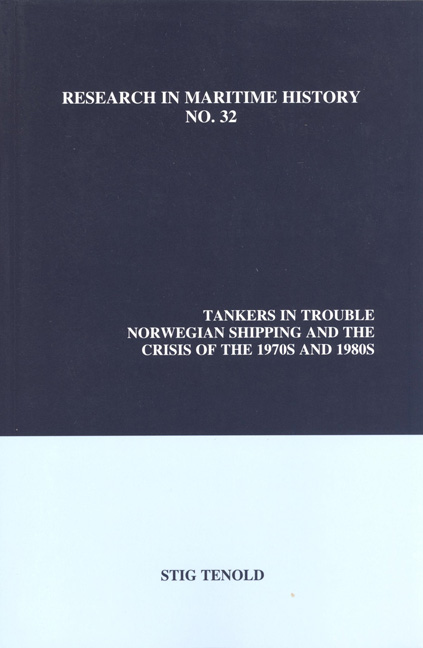Book contents
- Frontmatter
- Table of Contents
- List of Tables in the Text
- List of Illustrations
- Preface
- Chapter 1 Introduction
- Chapter 2 The Shipping Market after World War II
- Chapter 3 The Basis of the Tanker Crisis
- Chapter 4 The Contagion and Short-term Effects of the Crisis
- Chapter 5 Stage Two of the Crisis and the Long-term Changes
- Chapter 6 The Basis for the Crisis in Norwegian Shipping
- Chapter 7 Structural Transformations in Norwegian Shipping
- Chapter 8 The Fates of Four Norwegian Shipowners
- Chapter 9 Conclusion
- Appendices
- Bibliography: Select Bibliography
Chapter 8 - The Fates of Four Norwegian Shipowners
- Frontmatter
- Table of Contents
- List of Tables in the Text
- List of Illustrations
- Preface
- Chapter 1 Introduction
- Chapter 2 The Shipping Market after World War II
- Chapter 3 The Basis of the Tanker Crisis
- Chapter 4 The Contagion and Short-term Effects of the Crisis
- Chapter 5 Stage Two of the Crisis and the Long-term Changes
- Chapter 6 The Basis for the Crisis in Norwegian Shipping
- Chapter 7 Structural Transformations in Norwegian Shipping
- Chapter 8 The Fates of Four Norwegian Shipowners
- Chapter 9 Conclusion
- Appendices
- Bibliography: Select Bibliography
Summary
An analysis of Norwegian shipping at the aggregate level illustrates the basis for, and the implications of, the shipping crisis. But to understand fully the challenges that confronted shipowners it is necessary to look at individual companies and their behaviour both before and after the market crash. The farreaching, short-term effects of strategic decisions are illustrated through the fates of Knut Knutsen OAS, Hilmar Rekstens Rederi, Rederiet Peder Smedvig and Sig. Bergesen d.y. The analysis is based on the previous business strategy parameters: fleet structure, chartering and contracting.
The actions of the companies in the period leading up to the crisis are paramount in understanding their subsequent fate. The strategy during the heyday of high levels of contracting and soaring freight rates determined their ability to adapt to market changes, either facilitating, complicating or preventing a sustainable response to the new conditions. The four owners discussed here all had invested in the tanker sector. Although they represent a variety of strategies with regard to fleet structure and chartering, all had huge amounts of tanker tonnage on order prior to the freight market collapse.
Knut Knutsen OAS
The shipping company owned and managed by the Knutsen family had a long history in the liner sector. In the early 1970s it operated two liner services. The older of these, the Knutsen Line, Orient Service, a circular route in the Pacific Ocean calling in America, Asia and Australia, was established in the mid-1950s. To supplement this route, the company launched the Knutsen Line, West Australia-West Pacific, in 1972. Yet it was due to its participation in the tanker sector that Knutsen was particularly affected by the shipping crisis.
Before World War II Knut Knutsen OAS was the third largest shipping company in Norway. The founder, Knut Knutsen, was a distinguished man held in high regard in his hometown of Haugesund. After his death in 1946 the company was divided: one part was merged into Chr. Haaland og Son, while Knutsen's son, Ole Andreas, continued to manage the remainder under the name Knut Knutsen OAS.
The company dates back to 1896. The first vessel was used to export Norwegian herring. Knut Knutsen OAS is therefore a good example of the manner in which Norwegian shipping evolved from carrying domestic goods to becoming an important participant in the cross-trades.
- Type
- Chapter
- Information
- Tankers in TroubleNorwegian Shipping and the Crisis of the 1970s and 1980s, pp. 185 - 220Publisher: Liverpool University PressPrint publication year: 2006



